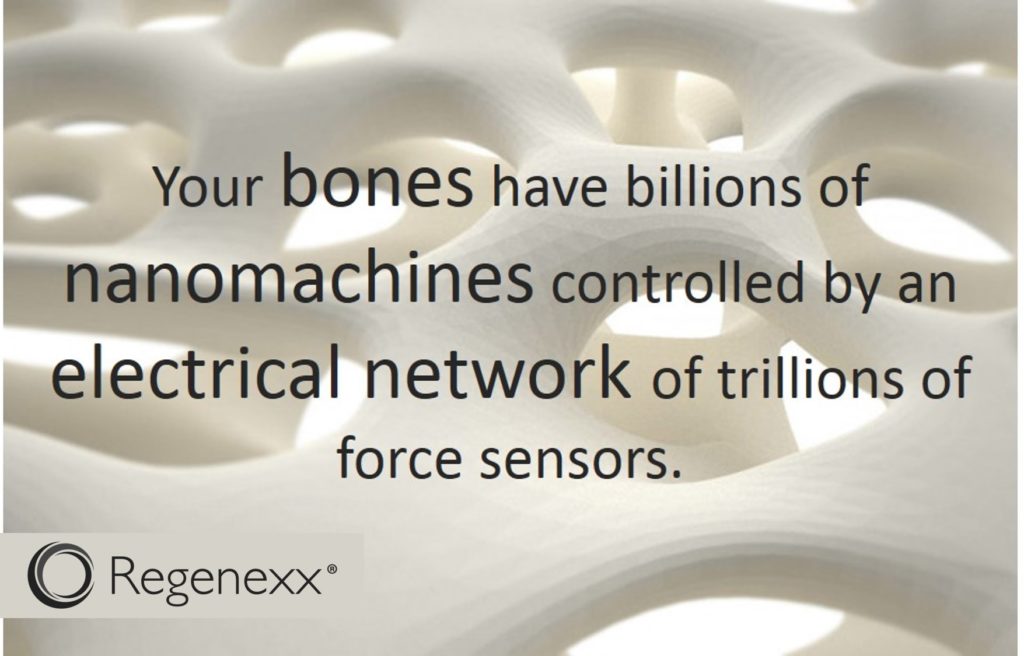The Body and Bones Electric: The Nanomachines Inside Your Bone
How Do Bones Work?
Most people (and some physicians) think of their bones as inanimate cement. In fact, in composition, your bones are more like hard plastic that gives and absorbs force. In addition, your bones are quite alive and actively respond to force by continually rebuilding themselves. For example, the bones of a ballet dancer are very different in internal structure than a couch potato. How does that work?
The secret behind how your bones react to forces makes a DARPA funded research project in nanobiology look like a bad high school science fair project. First, look at the beautiful patterns in the bone above. It’s internal engineering almost looks like something out of a sci-fi movie (this example has been artistically interpreted). These trabeculae (Latin for “small beams”) support the inside of the bone and continuously rework and rearrange themselves to shore up certain parts of the internal bone structure. This happens through highly complex cellular nanomachines with simple tasks that are commanded by an electrical network of trillions of sensors in the bone material.
When bone is loaded, it produces an electrical charge through the piezo-electric effect. Believe it or not, we’ve known about this for half a century or more, but we had no clear idea of what was generating the small electrical signals. We now know that it’s the individual collagen fibers in the bone that can each create a small electric charge, so each acts as a biologic force sensor in a network of startling complexity. Amazingly, the same system is at work in the tendons that power the bone.
For the system to be automatic, millions of these bone based cellular nanomachines must follow rules. What are the rules?
-Cells called Osteoblasts lay down new bone inside the boundaries of the bone.
-Cells called Osteoclasts clean up or resorb old bone or bone that’s no longer needed. They can eat of any bone they like, as long as it’s not electrically charged due to stress.
-Stem cells in the bone replace the worn out osteoblast and osteoclast nanomachines and then also make a new copy of themselves.
Allow these simple rules to run for any length of time and you get the beautiful structure seen above. In a ballet dancer, more stress in specific parts of the bone will mean that it will develop custom tailored patterns to counter and absorb those specific forces. These bones are quite different internally than say those of someone who runs a jack hammer whose arm bones will develop patterns inside that counter those forces.
Since bone reacts through these nanomachines, there are a few lessons for physicians and patients alike. First, when a bone spur forms somewhere (an extra appendage off the bone), it’s forming for a reason, so whacking it off surgically isn’t usually a smart idea, as the same forces that caused it will just cause it to grow back again. Second, you can look at how the bone is reacting to map the forces on the body and figure out where they’re excessive.
The upshot? You bones are quite alive. They’re made of very sophisticated nanomachines given simple rules that are commanded by trillions of electrical force sensors. We can either consider bone as dumb cement or a very smart organ. If we do the later, it can often teach us about exactly where they body is getting too much loading and hopefully we can use that knowledge to fix the problem before something important breaks!

If you have questions or comments about this blog post, please email us at [email protected]
NOTE: This blog post provides general information to help the reader better understand regenerative medicine, musculoskeletal health, and related subjects. All content provided in this blog, website, or any linked materials, including text, graphics, images, patient profiles, outcomes, and information, are not intended and should not be considered or used as a substitute for medical advice, diagnosis, or treatment. Please always consult with a professional and certified healthcare provider to discuss if a treatment is right for you.

